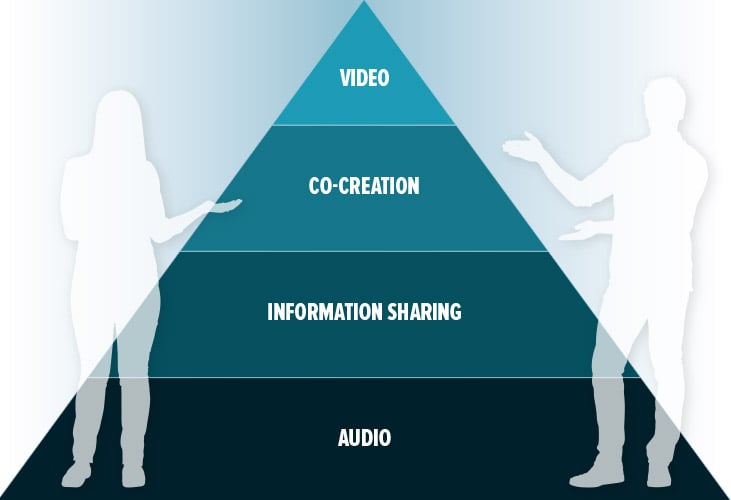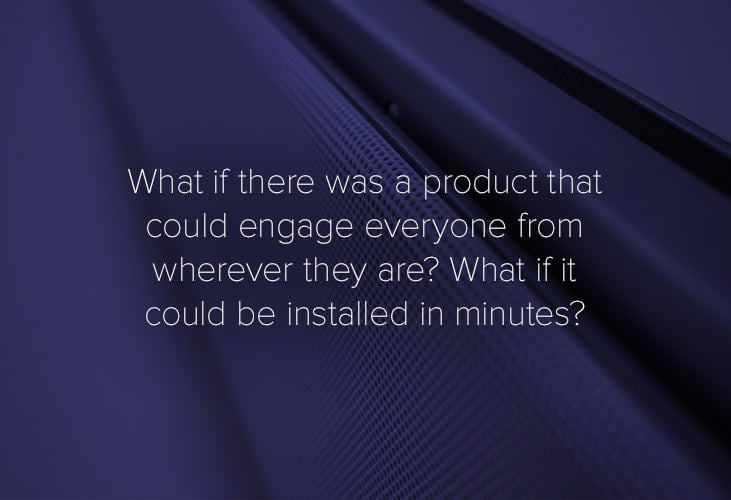Why collaboration needs advanced audio conferencing - and how to get it

Posted by Adrian Doughty on Sep 28, 2017 8:00:00 AM
Businesses are embracing collaboration like never before. And it’s no wonder. According to a survey by Deskmag, 71% of workers say they are more creative when they work as a team while 62% said their standard of work improved significantly.
In this video from the 2017 AV/IT Summit, I introduce the “Collaboration hierarchy of needs,” a framework for building and prioritizing conferencing systems. It’s an important guideline for the vital role AV/IT leaders have in supporting collaboration – from providing better mobile solutions to creating easy-to-use spaces for innovation. You’ll also learn how advanced audio conferencing is fundamental to creating the conditions that help teams, including remote workers, imagine and execute the next big idea.
VIDEO TRANSCRIPTION
Audio is fundamental to effective in-room collaboration
My name is Adrian Doughty. I am the national sales manager for Nureva. Today I’m going to talk about how audio is fundamental to effective in-room collaboration.
Quick poll in the room: how many of you have used the word collaboration in a document or email in the last 12 months? Don’t lie. Yes, everybody. Now, for those of you who have used it in the last 12 months, that means you’ve been talking about it for the last 24. How many of those same people feel it no longer has any meaning? [Audience laughs.] Okay. Last question. How many of you have dialed into a phone call and had to collaborate with other people from somewhere else, either in an airport or from a hotel room? [Nods in agreement with audience.]
Cutting through the noise
Cutting through the noise doesn’t necessarily mean that we’re going to talk through each other, it doesn’t mean that there’s not a lot of noise in this space. Because, frankly, a good collaborative session involves noise. We talked yesterday about how there’s better collaboration when a table is messy and people are sitting around it. We spoke about effective use of meeting rooms. Microsoft talked about that. So, how do you get through those challenges you’re facing as an IT leader to deliver good audio and enable that work?
Today I’ll tell you how audio is the foundation of collaboration, and then I’ll tell you how Nureva thinks differently about how you implement audio solutions into your small and medium-sized rooms. First let’s talk about some of the challenges you face.
The challenge of mobile
Challenge number one: increasing demand from the mobile workforce. It’s everyone from your customers to your staff. It can mean sessions like this, where I’m here and I have lots of people back in the office. (Well not really, I’m from Canada. They’re on a holiday today. I’m the only one working. But you get the idea.) Everyone wants to feel connected, but if you don’t pay attention to the audio, those remote people who are dialing into the room cannot feel connected. It is literally impossible. You are all AV/IT experts – think about the last time you were on a call where the device on the table didn’t have duplex capability, and people are trying to talk at the same time and no one can actually communicate.
Desire for workforce innovation
Challenge number two: an increasing desire for workforce innovation. Think of your “intrepreneurs.” Your new ways of working. Your scrum. Your agile. Your design thinking methodologies. All of these, in essence, are languages. And key to any language is the ability for everyone who’s involved and discussing and working through that language to understand and hear the words.
Why? Because the words in each language matter. If you’re talking to a design thinker and you’re talking about the empathy phase, or you’re talking to an agile person and you’re talking about a task moving from one bucket to another, those words have meaning and impact. And if you have a remote team who doesn’t feel connected, they won’t feel like they can participate. They’ll check out. And that can be dangerous.
Demand for more functional spaces
Third challenge: an increasing demand for more functional spaces. I don’t think we have to cover this too deeply. You are all designing some incredibly innovative spaces. I have spoken to most of you at this point, and the spaces I’ve heard about are phenomenal. Luckily, I also have the opportunity to travel around the country and meet with both corporate entities who are building these big innovation rooms in order to bring in customers to work together in them (think packaging companies and things like that), as well as universities, including Indiana University, who we heard from today, developing big, interactive, collaborative spaces.

Decreasing tolerance for complexity
The last challenge is the decreasing tolerance for the complexities involved in some IT audio implementations So, how do you create a room that meets the “Hierarchy of collaboration needs”? (Yes, my marketing team made that up.) If you think about it, audio is the bottom pillar of the collaboration workflow. And that’s how it’s been since time began. There was a time when the only way history was passed was orally. Only subsequently did it start getting recorded in cave paintings. After that came cocreation – people coming together to come up with ideas. This includes using those frameworks I mentioned, like agile, scrum and design thinking – people developing new thought patterns, new thinking, new actions.
And then came video. As a small company, Nureva does a lot of live video demos. And the number of people, compared to just last year, who are turning on the camera on the other end has doubled. As people become more comfortable with video, the more we’re able to make a human connection with someone anywhere in the world. I get up at midnight on a Thursday and I’m talking to a friend in Australia via video. There are no barriers. None. But, if they can’t hear me, video is irrelevant.
What if?
Let’s play a thought exercise. What is a video conference without video? It’s a phone call, right? What is trying to describe content without audio? (Audience reply: “Useless!”) Actually, it’s a book. But I like both answers. So, you can see how communication is layered and it all gets tighter together.
Now, what if there was a product that could engage everyone from wherever they are? Now, what if it could be installed in minutes and you didn’t have to hire an expensive contractor? What if you could pick up a screwdriver, plug in two cables, and within five minutes be ready to go? What if it integrated with whatever software or platform you were using? And, finally, what if it didn’t require ongoing support or maintenance, so it solves the decreasing acceptance of complexity we talked about?

A simple solution
Now, here’s the shameless plug. Nureva offers this technology. It’s the HDL300 audio conferencing system. It uses our Microphone Mist™ technology to fill the room with 8,192 virtual microphones. Then it uses a powerful processor to listen to every single one of those microphones simultaneously. It even enables active echo cancellation and location-based audio.
What does that mean? Think of these collaborative meetings you’re designing spaces for. Are people going to be sitting still? No. The idea is to get them up! It’s called active learning. The first word is “active.” You want them to be moving around and talking to one another.
How do you enable a space like that – from an audio perspective – for people who might be dialing in or watching remotely? What if they can’t hear when someone is at the wall? Or working on a panel? Or working back in the corner over there? It’s impossible. You need a way to engage these remote people as effectively as the people in the room.
Remote work will increase
The megatrends, or challenges, of work that I described earlier are only going to become more pervasive. Yes, some big companies are pulling their staff back to the office – we’ve all read those stories. But we still are having more virtual meetings and doing more remote collaboration and remote video than we have done in the last five years, in the last three years, even in the last two years.
And it’s not going to stop. There is going to be an increase in remote work because it’s easy – really easy – to fire up web conferencing technology and talk to someone anywhere in the world. And remember that audio is foundational. If you don’t have good audio, people who are dialing in or attending remotely can’t actually participate. And if you don’t pay attention to that, you’ll get service requests like, “Hey, can you fix the room?” Literally. A customer sent me a ticket that was generated from one of their users that was, “Hey, can you fix the room?” And it wasn’t that the TV wouldn’t turn on, it wasn’t that they couldn’t connect, it was that they couldn’t hear. How do you “fix” the room just for audio? It doesn’t make sense. But that’s what people feel. Audio is an incredibly subjective thing. Everyone wants to hear differently, hear perfectly. And, if you have a way to enable that – to fix the room – that problem disappears, and you can focus on the bigger issues that you’re dealing with.
The Nureva solution
The last point I want to make is why you should consider Nureva. It starts with why we created the HDL300. Nureva, at its core, is a company built on effective collaboration. What we want to do is help people work together, no matter where they are, using workflows that are traditionally analog – using tools and processes that they already understand, but adding the benefits of some of the new things that are out there to enable global collaboration.
For those of you attending my lunchtime session today, I’m also going to be discussing some of the things we’ve learned from setting up these new collaborative rooms from both an interactive perspective and an audio perspective. Thank you.

Now hear the difference
A Nureva® audio conferencing system fills a conference room with thousands of virtual microphones so everyone in a meeting can be heard. Hear a quick, no-pressure demo.

Posted by
Adrian Doughty
September 28, 2017
















